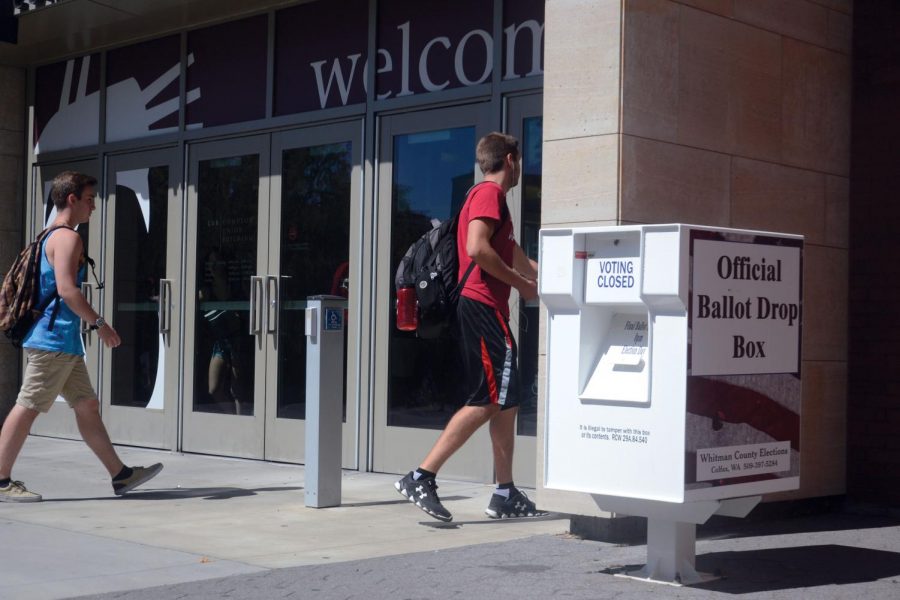Washington Secretary of State hosts Q&A on voter registration, mail-in voting
USPS recommends voters mail in their ballot at least seven days before the election or be postmarked by those dates
October 5, 2020
The state is likely to see a record voter turnout for 18-24 year olds, said Washington Secretary of State during a Q&A sponsored by WSU’s Student Diversity Center.
“In 2016 we had 4.2 million registered voters and this year we are at 4.7 million,” said Secretary of State Kim Wyman during the event Monday afternoon.
There has been an increase in mail-in voting over the last 40 years, she said. Mail-in voting, formerly called absentee voting, used to be reserved for people with disabilities or over the age of 65.
Mail-in voting is different from absentee voting because mail-in voting is automatically sent to every person registered to vote, but absentee voting must be requested, she said.
“It is not okay to vote on behalf of a deceased family member or to vote twice,” she said. “That is why it is a felony.”
Now, any resident in Washington can vote using the mail-in option, Wyman said. Individuals need to be registered to vote in their state and have an up-to-date residential address, she said.
Many states are going through the same hurdles Washington went through over a period of 40 years, but they are going through it in a three-to-six month period, she said.
There will be a large amount of misinformation online until election day, and it is going to look legitimate, Wyman said. Students should help direct people to important and accurate information to help increase voter turnout.
“We are also partnering with colleagues across this state and others in an effort called #TrustedInfo2020,” she said. “This is to drive people to legitimate sources they can trust.”
Pre-registration is going very well, and Wyman said she believes there will be a 90 percent voter turnout across all age groups.
“If people understand civic engagement from someone in their lives, they are more likely to become a lifelong voter,” she said.
A close election will determine the success or failure of mail-in voting, she said. If an election is close, it could cause the accuracy of mail-in voting to be called into question.
Washington is doing everything it can to ensure there are as few barriers as possible for voting, Wyman said. This includes audio and braille options.
“We will also have translation services for people who need help marking ballots,” she said.
However, the U.S. Postal Service’s slowdown will impact mail-in voting, she said. USPS recommends voters mail in their ballot at least seven days before the election.
“If you cannot mail the ballot in earlier make sure that it is postmarked,” she said. “It will still count up to 20 days after the election.”
People can also check votewa.gov to see if their ballot has been accounted for, Wyman said. The website will also state if the ballot is being challenged.
“A common reason for this is your signature,” she said. ‘If you submit a signature that isn’t registered your ballot will not count and this is common for 18-25-year-olds.”
Voting is empowering, she said. Choosing when, how and where a person votes is easier now without having to physically go to a voting poll.











Michael McCrath • Oct 10, 2020 at 4:55 pm
I have question: The “president” has indicated that “millions” of unsolicited ballots have been sent out across the land, and that any state doing mail-in voting is complicit ln that action. His rationale is that in such states one doesn’t have to request a ballot; it’s simply mailed out and any and all receive them. You know; dead people, kids, dogs…
But, we know that ballots are only sent out to registered voters. And, is it not true that, when you register to vote you are automatically and by definition also requesting a ballot? That seems intuitive. How could you be registered to vote and then deliberately be disenfranchised by not being sent a ballot?
Perhaps voters in states with no mail-in voting don’t understand that finer point. I mean, show me someone ignorant of the facts and I’ll show you a demagogue willing to set him/her straight.
Rodger Rinearson • Oct 7, 2020 at 11:04 am
What do I do if my ballot doesn’t get mailed to me?